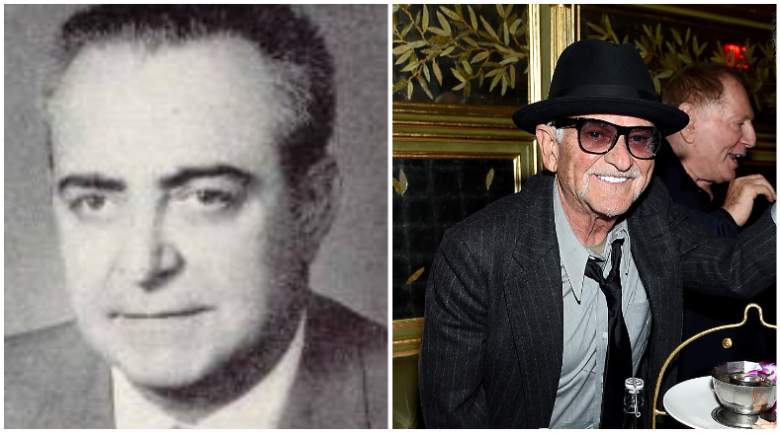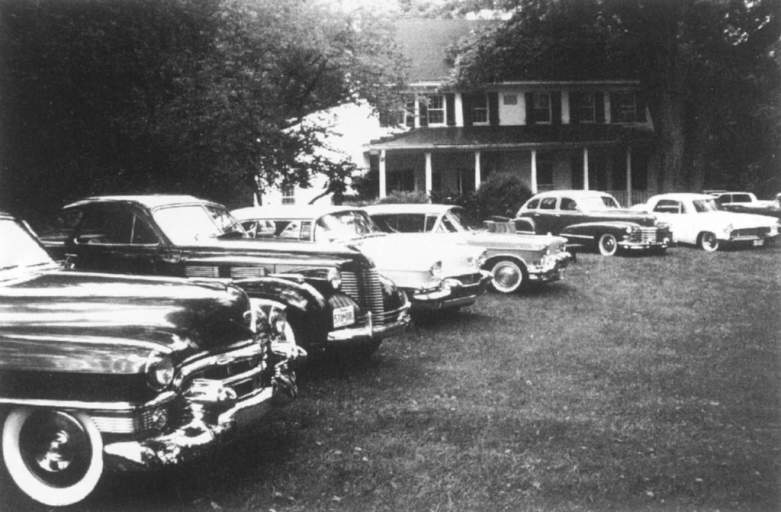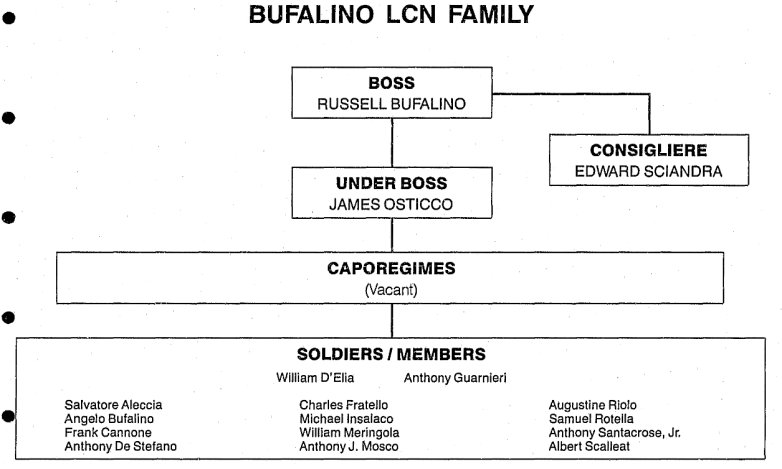
Getty Russell Bufalino (l) in real life and actor Joe Pesci from The Irishman.
Russell Bufalino was a powerful Pennsylvania Mafia boss known as “McGee” and the “Old Man.” He ran a string of garment businesses, but he was really at the helm of a ruthless crime family with roots in Sicily, and he was also a key figure in theories surrounding the disappearance of Teamster boss Jimmy Hoffa. Bufalino is featured in the new Martin Scorsese mob epic on Netflix, The Irishman, which focuses on labor official Frank Sheeran. (This article will have some spoilers for the movie because it adheres closely to real life in some cases.)
In real life, Russell Bufalino (played by Joe Pesci in The Irishman) was born in Sicily as Rosario Alberto Bufalino.
The titular character is Frank Sheeran, a labor official from Delaware with ties to Bufalino and the mob. The movie focuses on Sheeran’s confession – he said he killed Hoffa at the behest of Bufalino – in a 2004 book. Some experts don’t believe that Sheeran murdered Hoffa, although he was clearly linked to Bufalino, the crime chieftain who often is accused of giving the ultimate order to whack Hoffa even by those who don’t think Sheeran was the triggerman.
Hoffa’s murder has never been officially solved. No one has stood trial in his death, the principle suspects are all long dead (including Bufalino who died in 1994), and his body has never been found. The trail, though, seems to lead back to Bufalino in many theories.
Citizens Voice, which obtained Bufalino’s FBI file, described him as the “soft-spoken, eight-fingered Sicilian with a lazy eye, known to his closest associates as ‘McGee.'” You can read the more than 1,000-page FBI file obtained by Citizens Voice on Bufalino here.
One FBI report in that file indicated that “Sheeran was observed driving Russell Bufalino in Detroit right after Jimmy Hoffa’s disappearance,” Citizens Voice reported. What’s the real story of Russell Bufalino?
Here’s what you need to know:
Russell Bufalino Ran a ‘Powerful Cosa Nostra Family’ That the Government Warned ‘Should Not be Underestimated’

The Apalchin meeting.
A Pennsylvania Crime Commission 1989 report indicated that the Russell Bufalino Family, in 1980, was described as operating “in northeastern Pennsylvania, New York State and New York City” and “may be the most powerful Cosa Nostra Family in the Commonwealth…the power which is held by Bufalino and his Family should not be underestimated.” However, that was in 1980 and by 1989 the Family’s power was weakened as the old man aged.
The family traced its origins to the 1880s in the Pittston area of Luzerne County. Rosario Albert Bufalino, Russell’s real name, was born on October 29, 1903 in Sicily, the report says. He became the boss of the northeastern Pennsylvania Cosa Nostra Family in 1959, one of the nation’s “most ruthless and powerful organized crime figures.”
In fact, then 85 year old Rosario Bufalino was credited with arranging an infamous “Apalachin Convention” of leading organized crime figures in 1957. The commission’s report says the family’s power was “established in labor racketeering in the region’s garment and coal industries.” Bufalino traveled weekly from his Kingston home to New York City. In 1960, there were 35 active members, but the crime family was cut in half a decade later.

Pennsylvania Crime Commission report in 1989 on the Bufalino Crime Family.
The Brandt book, I Heard You Paint Houses, quotes Frank Sheeran as calling Russell Bufalino “the other one of the two greatest men I ever met.” His favorite song was “Spanish Eyes.” The famous Five Families of New York sought his counsel. The book says Bufalino didn’t want Jimmy Hoffa to run for union president again. Both were short men who were “solid muscle from head to toe.” They had an alliance and mutual respect that disintegrated after Bobby Kennedy’s war against the mob and Hoffa’s subsequent attempt to regain control of the Teamsters. The mob thought Hoffa was a rat and their share of the pension system was in peril. Bufalino, Sheeran says, decided that Jimmy Hoffa had to go and asked him, a friend, to carry out the hit because Hoffa would be unsuspecting.
The book says that Time Magazine reported at the time that Bufalino and Chicago mob boss Sam Giancana “had worked on behalf of the CIA in 1961 in the Bay of Pigs invasion of Cuba and in 1962 in a plot to kill Castro.”
Russ was “very spry,” and born in Sicily but “spoke perfect English.” He was married to wife Carrie but they didn’t have children, the Brandt book says. Russell said of Jimmy, according to Sheeran in the book: “Your friend made one threat too many in his life… there won’t be a body. My Irishman, we did all we could for the man. Nobody could tell that man what it is. We get into Detroit together Wednesday night.” At the time, Hoffa was “as famous as Elvis.”
Bufalino’s wife, Carolina Sciandra, Carrie, was “related to the Sciandra line of La Cosa Nostra.” Her family didn’t have bosses in it but went back “to the earliest days of the American Mafia.” Sheeran said that, of all of the crime bosses he met, Russell’s “mannerisms and style” most fit those depicted by Marlon Brando in The Godfather. Yet his name was not widely known to the public, and he liked it that way.
In the late 1970s, Bufalino was found guilty of extortion and sentenced to four years in prison. His first prison term came in 1978. By 1989, Bufalino was in ill health and incarcerated at the Medical Center for Federal Prisoners in Missouri. He was convicted of extorting a man named Jack Napoli.
The Family’s underboss was named as James Osticco, 76, in that report. The Bufalino Family was “involved in illegal gambling, loansharking, narcotics trafficking, and labor racketeering,” according to the report, which added that it was “involved in labor racketeering with members of the Teamsters Union.”
The Family had a “long and veiled relationship with MC and it subsidiary, Universal Pictures,” according to The Commission.
Bufalino’s Mafia Ties Dated Back Decades at the Time Hoffa Disappeared
A 1960 article in the Walkes-Barre Times Leader described Russell Bufalino as a “Pittston drapery manufacturer who is facing deportation to Italy.” It said that Bufalino was then serving a five-year sentence for a conviction in a conspiracy of silence case that grew out of a 1957 “crime convention” in New York.
According to the Times Leader, Russell Bufalino was born Oct. 3, 1903, in Sicily. The crime family he ran until his 1994 death was “one of the country’s most effective and influential crime families,” the newspaper reported, but he lived in an “unassuming house” while running everything from “dress factories in West Pittston to casinos in Havana, Cuba.”
By 1953, the FBI was calling him “one of the two most powerful men in the Mafia of the Pittston, Pa., area,” Times Leader reported, adding that Bufalino once worked as a mechanic in the Canada Dry Ginger Ale Bottling Co.
When he died at age 91, the newspaper called him “the last of Pennsylvania’s old-school Mafiosi” and the “don of dons.”
A 2016 article in Penn Live reported that the The Bufalino crime family “is one of three prominent La Cosa Nostra families in Pennsylvania,” but its power has waned.
A March 1980 article in the Times Leader in Wilkes-Barre reported that Russell Bufalino was “identified by state and federal authorities as the head of a large organized crime family in northeastern Pennsylvania.” Already 76 years old by that time, he was sitting in federal prison in Danbury, Connecticut after being convicted in 1977 of conspiracy in a death threat case.
Bufalino was said to be a partner in ADS Contracting Co., a garment firm.
Pittston, where Bufalino’s crime operation was based, was considered in the “same league” as cities like New York, Los Angeles and New Orleans “as headquarters for organized crime,” the Times Leader reported in February 1980.
The article reported that Buffalino was listed in federal documents “as not only leader of a Mafia family in Northeastern Pennsylvania but as one of the ruling members of the Mafia’s national council, composed of various organized crime figures from throughout the country.”
Writer Stephen Brill identified Bufalino as playing a “key role” in Hoffa’s disappearance in a book on the Teamsters. In addition, he was accused of a horse race fixing scheme at Pocono Downs and in the “murder and attempted murder of Teamster officials in Philadelphia and Delaware,” the Times Leader article reported.
In 2004, an article in the Detroit Free Press discussed Sheeran’s confession. It stated that the FBI has “long suspected that (Tony) Provenzano henchmen – brothers Thomas and Stephen Andretta and brothers Gabriel and Salvatore Briguglio – killed Hoffa to prevent him from regaining the Teamster presidency.” They were worried he would cut off “mob access to union pension funds,” according to the Free Press.
Sheeran claimed that Bufalino ordered him to kill Hoffa because national Mafia figures were sick of Hoffa threatening to cut the mob off from the union and thought he might be an FBI snitch. Sheeran claimed that Hoffa thought he would protect him and was driven by foster son Chucky O’Brien. He implied the Andretta brothers and Sal Briguglio were at the death house, the Free Press reported.
He claimed that, brought to a house in Detroit, Hoffa realized it was a hit but it was too late. He said he shot him “in the back of the head behind his right ear. My friend didn’t suffer,” according to the Detroit newspaper. Sheeran said that Bufalino claimed Hoffa’s body was burned in either a trash incinerator or funeral home, according to The Detroit Free Press article. O’Brien wasn’t involved in the murder, he said. The newspaper said O’Brien denied Sheeran’s account and that those named had alibis.
READ NEXT: Frank Sheeran: The Real Story.